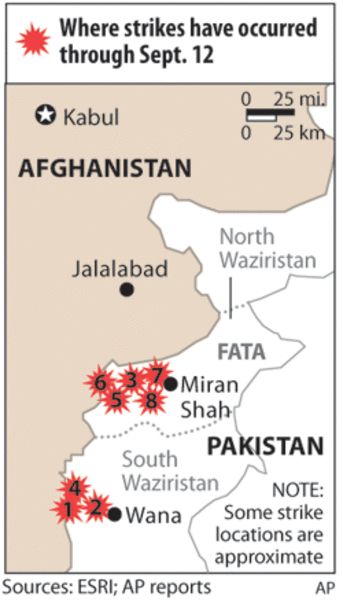U.S. airstrikes test alliance with Pakistan
Loading...
| New Delhi
More than at any time since Pakistan pledged its support to the war on terror in 2001, America's alliance with the country that is home to Al Qaeda and Taliban leadership is showing signs of significant strain.
America's top military officer, Adm. Mike Mullen, flew to Islamabad to meet with the Pakistani prime minister and Army chief Wednesday. He sought to quell mounting anger about recent US attacks against militants in Pakistan – eight missile strikes and a first-ever ground assault since Aug. 13.
A day earlier, a Pakistani Army spokesman had said soldiers would fire on US troops if they came into Pakistan again.
The relationship is increasingly marked by frustration and a lack of trust, and Admiral Mullen's need to rush to Pakistan – his fifth visit in the past year – points to a new and testing phase for the US-Pakistani alliance.
"This is the toughest period" of the seven-year alliance, says Moeed Yusuf, an analyst at Boston University. "Each side is testing the waters" to see how far it can push the other.
As America turns more of its attention from a relatively stable Iraq to a rapidly deteriorating Afghanistan, it is growing impatient with Pakistan's inability to rein in militants who use the country's loosely governed tribal areas as a base to attack Afghanistan. Some $11 billion in American aid to Pakistan – intended to build up the Army's counterinsurgency capabilities – has accomplished little.
"The Army has used 80 percent of it to buy weapons better used against India," such as fighter jets, says Ahmed Rashid, a political analyst in Lahore. "It has not gone to [building up] civil society [in the tribal areas], it has not gone to changing part of the Pakistani Army to fight an insurgency."
Adding to the sense of distrust within the Beltway is a growing conviction that elements of the Pakistani state – in particular the Inter-Services Intelligence directorate (ISI) – are actively working with militants.
Critics have long argued that Pakistan grooms militants as a proxy army that it can use to retain influence in Afghanistan and Kashmir. But CIA evidence that the ISI was complicitous in the July bombing of the Indian Embassy in Kabul proved a turning point, says Daniel Markey, an analyst at the Council on Foreign Relations in Washington.
"It reduced confidence that the Pakistani Army was up to doing the right thing," he says.
Adds Mr. Yusuf, the Boston University analyst: "There's no room for giving the benefit of the doubt anymore."
America's new aggressiveness in Pakistan comes amid – and perhaps because of – this declining confidence. Hours after Mullen, chairman of the Joint Chiefs of Staff, vowed to "respect Pakistan's sovereignty" Wednesday, the US launched another missile strike into South Waziristan.
Lessons from Iraq
The goal is to kill and harass senior militant leaders as effectively as the US did in Iraq. A new generation of the Predator drones used in Iraq is now being deployed along the Pakistan-Afghan border, the Los Angeles Times reports. The drones have an wider array of sensors to make identification of suspects easier – even inside buildings.
Even to make Taliban and Al Qaeda leaders "feel they can't stay in one place for more than one night" might begin to have a psychological effect, according to Mr. Markey. They have felt relatively safe in Pakistan until now, he says. If the strikes succeed, he adds, "it makes the political cost worthwhile."
But this is a precarious line to tread, as witnessed by Mullen's hastily arranged trip. "The Pakistani response [to American military operations] may have been more vociferous than anticipated," says Markey.
The people's outrage is not altogether a surprise. Ever since the United States used Pakistan as a staging area for the resistance of the Soviet invasion of Afghanistan in the 1980s – whipping up religious fervor to unite the Islamic world against the Soviets – Pakistanis have seen America as meddlers.
America's presumption to carry out brazen attacks in Pakistan is confirming that view.
"Trying to overcome terrorism through such tactics will only help [in] aggravating Pakistani citizens' hatred against the US," says Ferdos Wasif, another Lahore resident. She adds that the arrival of Mullen – instead of a civilian politician – shows that America's interest in Pakistan is only military.
Yet the warning Tuesday that Pakistani troops would fire on US troops suggests that the Pakistani Army, too, feels antagonized. From the beginning, it has been loath to go to war in the tribal areas. The militants most active in Afghanistan are not seen to be a threat to Pakistan, and fighting a counterinsurgency would be immensely difficult for an army built to contend with the huge Indian military.
The recent attacks may make it harder for Army Chief Ashfaq Kayani to push through reforms. "The most dangerous thing is that rising anti-Americanism in the Army will make it difficult for Kayani to get things done," says Mr. Rashid.
Cooperation needed
In the end, America will need the Pakistani Army. To destroy the insurgency, "we need to displace these groups in a more permanent way," says Markey of the Council on Foreign Relations – something only the Pakistanis can do.
With the Pakistani economy in dire condition, the Pakistanis will need the Americans, too. To step back from the brinkmanship of the past few weeks, the two countries must begin to recast the relationship forged under Pakistan's former president Pervez Musharraf.
This means dialogue with Pakistan's new military and civilian leaders to build trust and to get a clearer sense of what Pakistan can realistically do against militants, says Markey: "That [effort] needs to be really upgraded before we throw in the towel."
• Rana Kashif contributed from Lahore, Pakistan.





